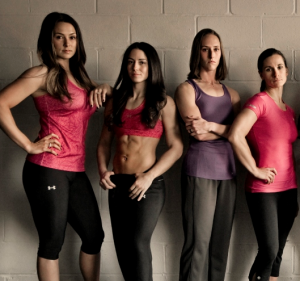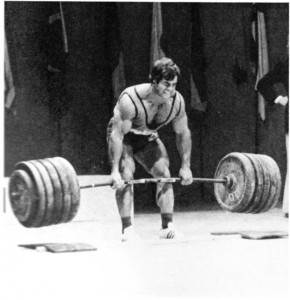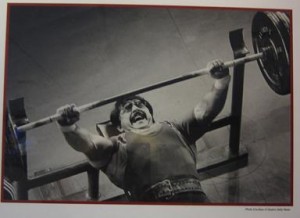After you’ve been training for more than a year or so, there’s really only one way to get stronger on barbell lifts: working up. It doesn’t matter if you’re still doing 5×5 or 5/3/1, once your squat gets up over 225 or so, you need to know how to gradually progress your warm-up sets so that you can hit your main sets with your body and nervous system primed to give your best effort.

These girls work up. You need to work up to these girls… (Look up Girls Gone Strong).
It’s very simple to do, but most people don’t do it. They’re in a rush and so they blow through two or three quick warm-up sets with little thought to form. Then they’re loading up the bar and ultimately missing lifts or falling way short of what they COULD have lifted that day because they didn’t work up properly.
Know this: the warm-up sets you take to get up to your main set of the day are MORE important than the main set itself.
That’s because you still get a training effect from the process of working up. Those sets, though they should feel fairly easy, contribute to your total volume, and your potential to get bigger and stronger.
And you know what’s really cool? You don’t have to count them. Just work up in steady, gradual increments and the volume will take care of itself. Do them crappy and fast, and you won’t groove the technique you need to do well on your work sets. Do them patiently and proficiently, and you could be looking at new PRs.
Depending on how many reps you’re going for, there are a few different ways to work up.
The Classic Workup
This is what most powerlifters do. You aim to do a very heavy single rep or a max and take a lot of work-up sets to get there. The reps—aside from maybe the first two sets—need to be low so that you conserve energy. Working up IS NOT pyramiding down. Two totally different concepts.
In a pyramid, like bodybuilders use, you start with high reps (like 10) and work down each set to low reps (like 2). This is okay for building muscle because you hit the muscle fibers that are involved more with endurance on the higher-rep end of the spectrum and the fibers associated with pure strength when you get to the low reps. That covers all your bases for targeting muscle fibers for mass gain. But it’s too many reps done with too much weight too soon to be ideal for gaining strength.
By the time you get down to that 2-rep set, you’re not lifting what would have been a weight you could handle for 2 reps several sets ago.
So, when working up, your reps don’t go above 5, unless, as mentioned above, you want to start off with one or two high-rep sets with just the bar or small plates to get some blood flowing into the target muscles.
From there, you add weight and, as you approach your max, take off a few reps to prevent fatigue. You can go from 5’s to 3’s and then, when you get within about 50 pounds of your target weight, hit some singles (1 rep).
Some lifters like to add weight to the bar in the order that’s easiest, or that makes nice round numbers. They’ll do a set with the empty bar (45 pounds), and then throw a plate on each side (135 pounds), and then go up to 185, 225, and so on.

Franco
Now, if you’re Benedikt Magnusson, the deadlift world record holder, or some other insanely strong guy, this is perfectly fine and I’ll stay out of your way. But if you’re me or someone else who doesn’t need an hour to work up to an appropriate weight, you should choose smaller increments and work up more gradually.
I think jumps of 30 to 50 pounds is much better. It ensures that you get a sweat going, a little pump, and enough practice with reps that your technique is really dialed in by the time you need it most. Going from 135 to 185 to 225 just because it makes for the easiest plate changes and no counting is just being lazy, and you could pay for it with injury or missed lifts.
Here’s another trick. As you’re working up, and especially when you’re going all the way up to a max, the bar tends to feel very heavy BEFORE you know it should. For instance, you know you can squat 315 but you hit 265 for 3 and it feels like the ceiling landed on you. This is a moment of truth.
It’s very easy to be intimidated at this point and want to turn back around and go lighter or call it there for the day. But you don’t have to do that. Simply back off a few pounds and hit an easier set, and then continue working up. The effect this has can be like magic.
How much do you back off? That’s up to you. I’d say 20 to 40 pounds, or just enough to make the set feel easy without it taking you back to the beginning of the work up. So maybe you go to 245 for two or three reps and then go right back to adding weight.
Here’s how you might work up to a max squat of 315.
Empty bar x 10
95 x 8
135 x 5
175 x 5
205 x 5
235 x 3
265 x 3
245 x 2
295 x 1
315 x 1
The Back-Off Work-Up
Most of your workouts aren’t going to find you maxing out, of course. You may work up to a top set of 5, 3, 7, or 8 reps. In this case, I would work up a little differently but still try to ensure that I could use the heaviest weight possible for the chosen rep range.
I’ll work up until the weight feels heavy and then back down for one set as described above. Then I’ll keep going up and do one set that’s HEAVIER than the target one for the day, but I’ll do it for much fewer reps. So if I’m trying to bench 250 for 5, I would do a set of 260 for one first. Yes, that set of 260 is hard—maybe it’s my three-rep max—but I’m only doing it for 1 rep. That’s not so bad.

Is it just me, or were people stronger back in the 70s?
I rest a little longer, and then go for 250. It feels much easier. I’ve now essentially made 250, my main work set, my BACK-OFF set. It’s almost a relief to do now!
Here’s how it might look.
Empty bar x 10
95 x 8
135 x 5
165 x 5
195 x 3
225 x 3
205 x 2
260 x 1
250 x 5
The Back-Off Work-Up For Reps
This is another trick I like to do with body-weight exercises like chinups and dips. Yes, you can work up on these, too. I throw in kind of a wave loading thing just to get the nervous system extra revved. Gradually increase the weight and keep the reps very low just to send the signal to your muscles that you need more and more motor units to complete the lift. Then lose the extra weight entirely and make your body feel light by comparison.
A plan for getting max reps on chinups:
45lbs x 5
70 x 3
85 x 1
Body weight x AMRAP
Join the Discussion
Related Content